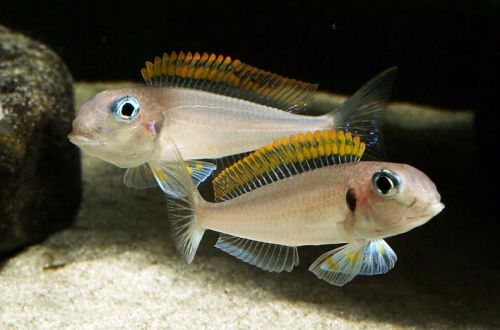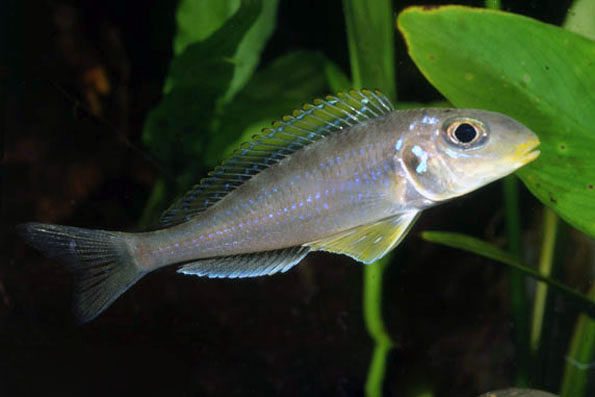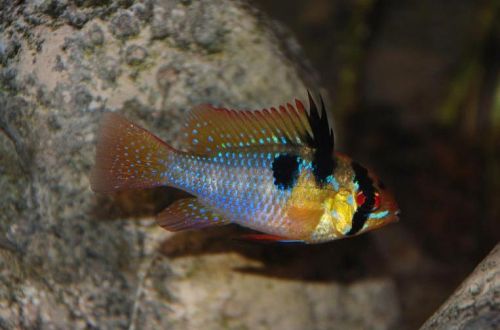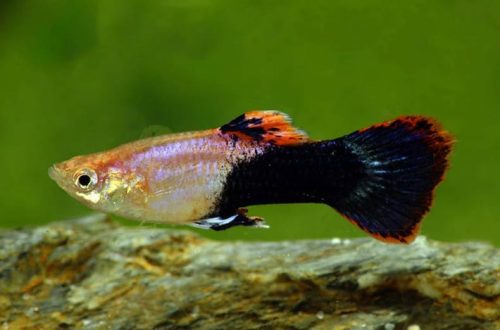
Xenotilapia flavipinis
Xenotilapia Flavipinis or Yellow Sand Cichlid, scientific name Xenotilapia flavipinnis, belongs to the Cichlidae family. Endemic to Lake Tanganyika in East Africa, they live in regions with a sandy bottom. A peaceful and calm fish, it is easy to keep, if you provide suitable conditions for it, as well as interesting behavior during the mating season.

Contents
Description
Adult individuals reach a length of about 9 cm, have an elongated body tapering towards the tail, a large head with large eyes. The coloration is light gray or silvery, a characteristic feature of the species is a ribbed yellow dorsal fin. Sexual dimorphism is weakly expressed, it is rather problematic to distinguish a male from a female.

Brief information:
- The volume of the aquarium – from 100 liters.
- Temperature – 23-27°C
- Value pH — 7.6–9.0
- Water hardness – medium to high hardness (10-25 dGH)
- Substrate type – sandy
- Lighting – moderate
- Brackish water – no
- Water movement – weak, moderate
- The size of the fish is 12–13 cm.
- Nutrition – high protein foods are preferred
- Temperament – conditionally peaceful
- Content in a group of at least 6–10 individuals
Food
In nature, it feeds near the bottom, sifting sand with its mouth in search of small invertebrates. In a home aquarium, live or frozen meat foods, such as bloodworms, should be fed. However, the best choice would be specialized feed from well-known manufacturers.
Maintenance and care
The size of the aquarium for a small flock of fish should start at 100 liters. The design is quite simple and includes two main components – a sandy substrate and several stones, rocks from which caves and grottoes are built. As an alternative to the latter, you can use decorative elements or ordinary ceramic pots turned on their side.
Particular attention should be paid to the quality and composition of the water, it must be very clean and have high pH and dGH. Along with the weekly replacement of part of the water (15–20% of the volume) with fresh water, a prerequisite is the availability of a productive filtration system, preferably with filter materials that help maintain the required hydrochemical composition of water.
Behavior and Compatibility
Calm and peaceful fish, if kept in a group of 6-10 individuals, with a smaller number, intraspecific conflicts may arise. During spawning, the couple may also show some hostility, but this is due to the desire to protect their territory and masonry. They get along well with other non-aggressive species that can live in similar conditions.
Breeding / breeding
With the onset of the mating season, a male / female pair stands out from the group of fish, they choose a small area at the bottom of the aquarium (about 30 cm in diameter), which they then actively protect from relatives. The female lays several eggs on the ground and, after fertilization, takes them into her mouth. The process may be repeated several times.
The female keeps the eggs in her mouth for about 9–12 days, the male guards the territory at this time, then they change – this time the male takes the eggs, and the female swims away for protection. After another ten days, the fry that have already appeared are released into free swimming. However, for the first weeks they continue to be near their parents and, in case of danger, hide in the mouth of the female or male.
Fish diseases
The main cause of most diseases of cichlids from Lake Tanganyika is unsuitable housing conditions and poor quality food, which often leads to such a disease as African bloat. If the first symptoms are detected, you should check the water parameters and the presence of high concentrations of hazardous substances (ammonia, nitrites, nitrates, etc.), if necessary, bring all indicators back to normal and only then proceed with treatment. Read more about symptoms and treatments in the Aquarium Fish Diseases section.





